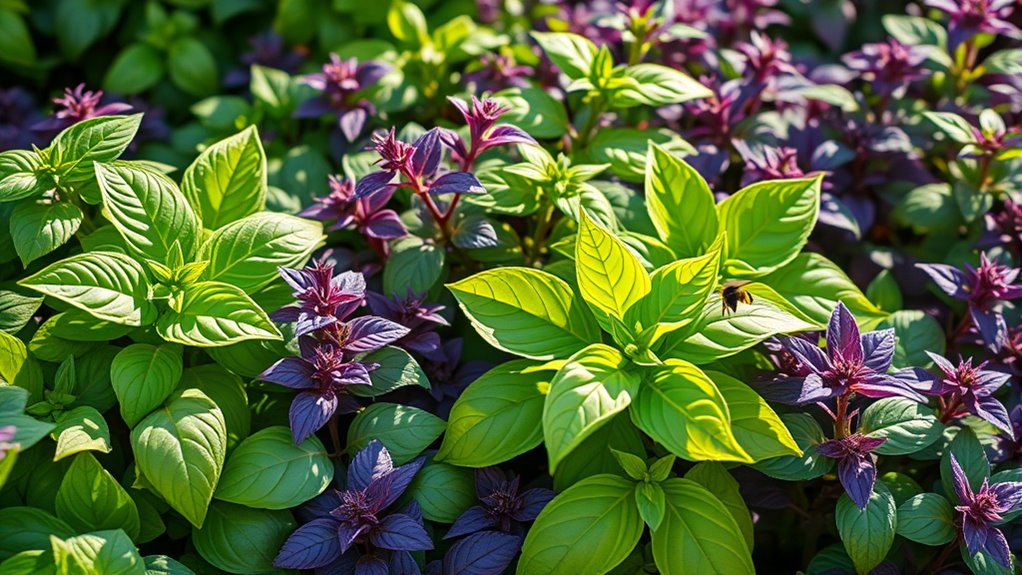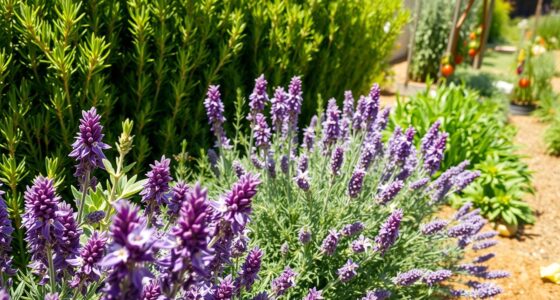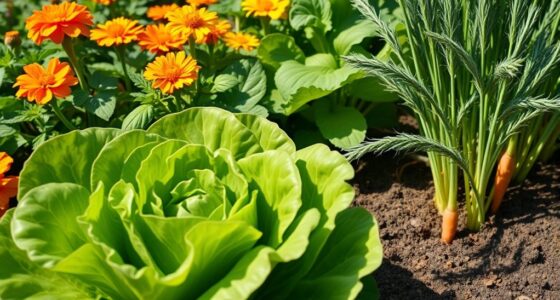If you’re growing basil, consider companion plants like tomatoes, peppers, and eggplants to boost flavor and naturally repel pests like aphids and whiteflies. Marigolds and borage also work well, attracting beneficial insects while deterring harmful ones. Oregano can protect basil from pests, and these plants together create a healthy, thriving garden. Keep exploring for more tips on optimizing your garden’s success with basil and its ideal companions.
Key Takeaways
- Plant basil near tomatoes, peppers, and eggplants to enhance flavor and naturally repel pests like aphids and whiteflies.
- Grow basil alongside marigolds to deter pests such as nematodes and aphids while adding visual appeal.
- Combine basil with borage to attract beneficial insects, improve pollination, and support overall plant health.
- Pair basil with oregano for mutual pest resistance and to create a resilient, low-maintenance herb garden.
- Incorporate native, beneficial plants like marigolds and borage to boost pollinators and promote a sustainable garden ecosystem.
Tomatoes and Basil: A Classic Pairing for Flavor and Pest Control
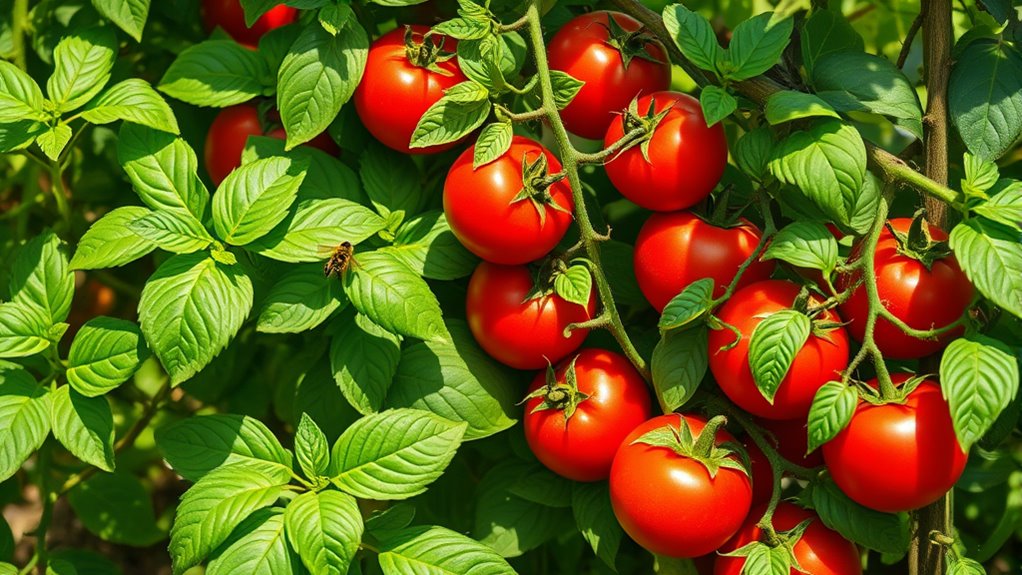
Planting tomatoes and basil together is a popular choice because it enhances flavor and provides natural pest control. When you grow basil near your tomatoes, the herbs release aromatic oils that improve the tomatoes’ taste, making your dishes more vibrant. Additionally, basil acts as a natural repellent for pests like aphids, tomato hornworms, and whiteflies, reducing the need for chemical sprays. This pairing also benefits your garden’s health, as basil can help deter certain soil-borne diseases that affect tomatoes. To maximize these benefits, plant basil close to your tomato plants, but make certain they have enough space to grow comfortably. Proper watering and soil preparation will further promote healthy growth, resulting in a bountiful, flavorful harvest. Incorporating garden pest management strategies can further protect your plants and ensure a successful harvest. Utilizing companion planting techniques can also enhance overall garden health and productivity, especially when combined with integrated pest management approaches to minimize chemical use. Selecting the right soil nutrients and maintaining proper watering schedules will support both plants’ growth and resilience. Embracing curiosity about plant interactions can help you discover even more effective gardening techniques.
Peppers and Basil: Enhancing Growth and Repelling Pests
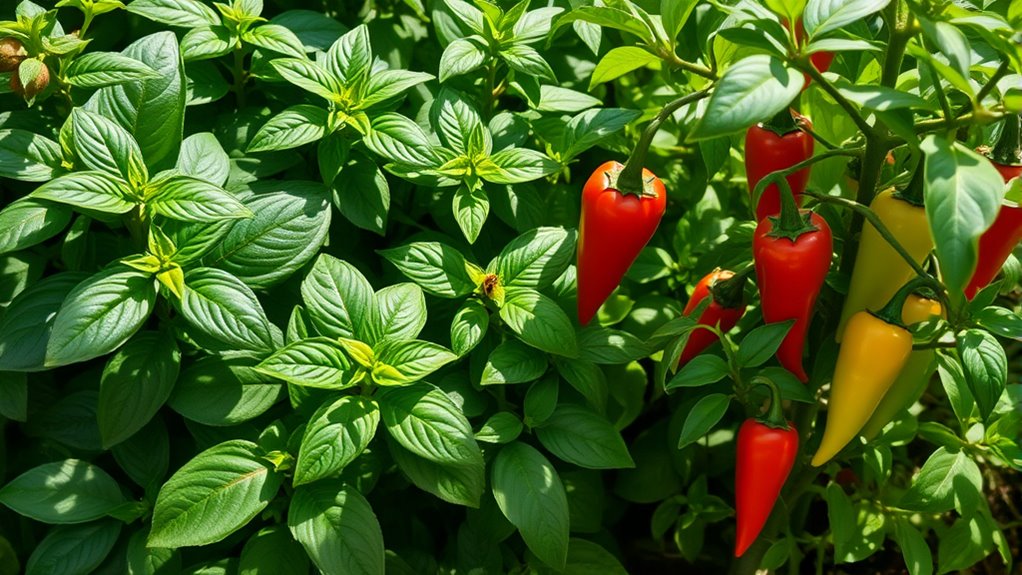
When you grow peppers alongside basil, both plants can thrive by supporting each other’s health and productivity. Basil helps repel pests that typically target peppers, like aphids and spider mites, while peppers can improve basil’s flavor and growth. This pairing also maximizes space and encourages healthy air circulation. To optimize this companion planting, consider these tips:
- Plant basil around the base of pepper plants for effective pest deterrence
- Use basil varieties like sweet basil or Thai basil for added flavor benefits
- Keep the soil well-drained and rich in organic matter for both plants
- Harvest basil regularly to promote bushier growth and continuous pest resistance
- Avoid planting basil too close to other aromatic herbs that might compete for nutrients
- Incorporating wall organization systems can help keep your garden tools and supplies tidy, making it easier to care for your plants.
- Additionally, understanding plant spacing can improve air flow and reduce disease risk, promoting healthier growth for both peppers and basil.
Basil and Marigolds: Natural Pest Deterrents and Aesthetic Appeal
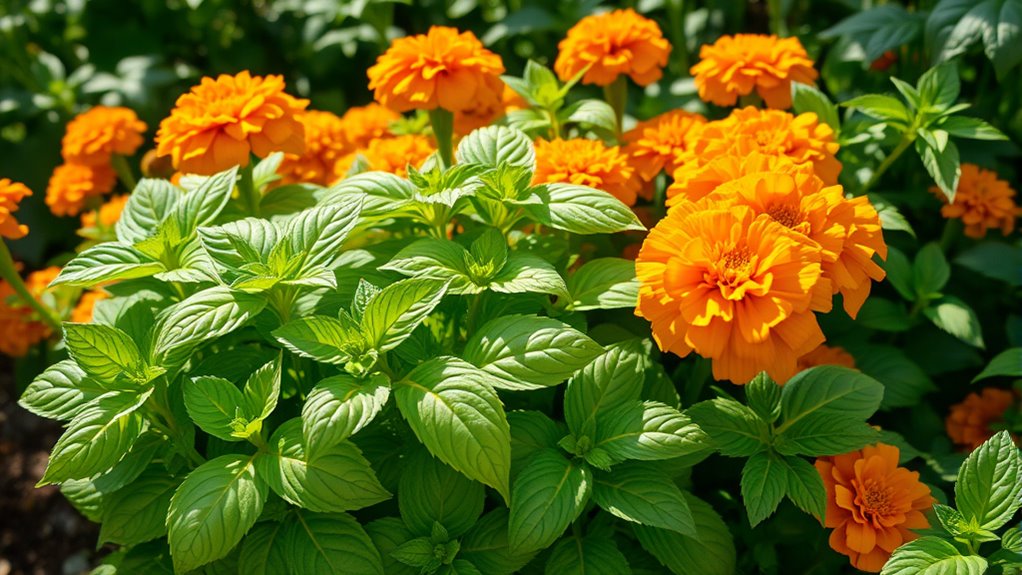
Adding marigolds alongside basil not only enhances your garden’s visual appeal but also provides a natural defense against pests. Marigolds emit a scent that repels aphids, nematodes, and other unwanted insects, giving your basil a better chance to thrive. Their bright, cheerful flowers create a vibrant contrast with lush green basil leaves, making your garden more attractive. Planting marigolds near basil is easy—just place them a few inches apart to maximize pest deterrence and aesthetic impact. The combination adds a lively, colorful touch while reducing the need for chemical pesticides. Additionally, incorporating diverse garden designs can further elevate the overall look and functionality of your garden space. Creating a balanced plant arrangement encourages healthy growth and complements the natural pest-repellent properties of marigolds and basil, fostering a thriving garden environment. By pairing these plants, you create a harmonious environment that promotes healthy, pest-resistant basil and elevates the overall look of your garden space.
Eggplants and Basil: Promoting Healthy Growth and Disease Resistance
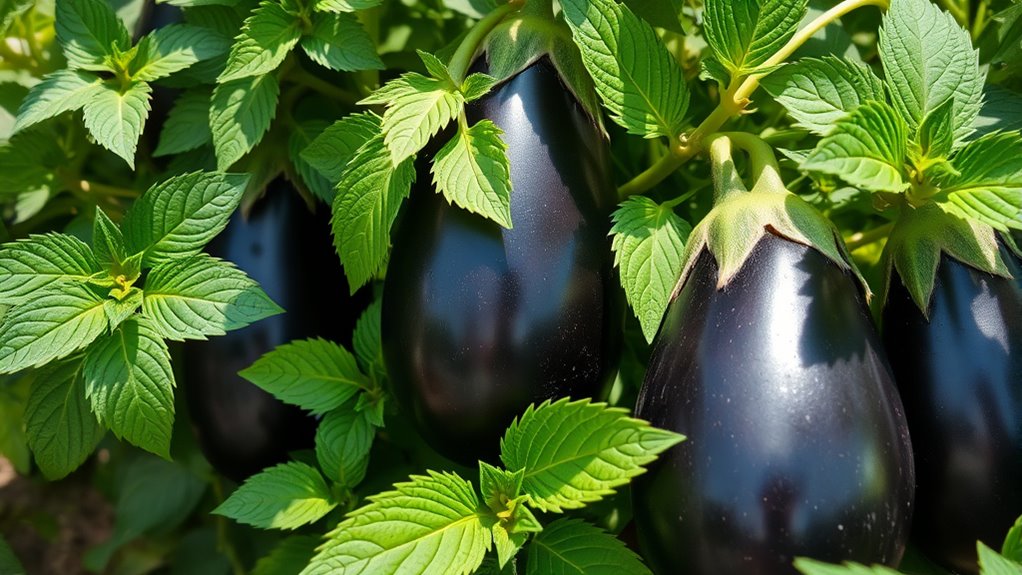
Planting basil with your eggplants can help keep pests away and strengthen their defenses. Plus, basil’s presence may boost the flavor of your eggplants, making your harvest even tastier. Together, they create a healthier, more resilient garden.
Pest Repellent Properties
Basil’s strong aroma acts as a natural repellent for various pests that commonly attack eggplants, such as aphids, whiteflies, and spider mites. When you plant basil nearby, its scent helps keep these pests at bay, reducing the need for chemical treatments. Basil’s volatile oils disrupt pest feeding and mating, making it less likely for infestations to take hold. Additionally, basil can attract beneficial insects like ladybugs and parasitic wasps that prey on pests, enhancing your garden’s natural defenses. Growing basil alongside eggplants creates a pest-resistant environment, promoting healthier plants and better yields. Its repellent properties make basil an excellent companion in organic gardening, protecting your eggplants without harmful chemicals. Companion planting also supports integrated pest management by encouraging biodiversity in your garden. Incorporating pest-resistant plants can further strengthen your garden’s defenses and reduce reliance on chemical controls. Using pest control methods that align with organic practices can optimize your garden’s health and productivity.
Enhanced Flavor Profiles
When basil grows near eggplants, it enhances their flavor and overall health through natural interactions. Basil releases aromatic compounds that can boost eggplant’s taste, making it more vibrant and rich. This plant proximity also helps improve the soil’s health, encouraging better nutrient uptake. As basil grows, it can suppress certain soil-borne diseases that might otherwise weaken eggplants. The combination creates a symbiotic relationship where both plants thrive, resulting in healthier, more flavorful produce. Additionally, basil’s presence can reduce the need for chemical interventions, preserving the natural integrity of your garden. By planting basil alongside eggplants, you not only elevate flavor profiles but also promote stronger, more resilient plants. This simple pairing can considerably improve your garden’s productivity and the quality of your harvest. Incorporating companion planting techniques can further optimize plant health and yield for your garden. Some gardeners also use natural pest control methods alongside these plants to maintain a healthy garden ecosystem. Moreover, understanding soil health can help in selecting the best conditions for both plants to flourish. Recognizing the importance of plant interactions can guide you in designing a more effective and sustainable garden layout. Additionally, selecting the right organic practices can support long-term soil fertility and plant vitality.
Borage and Basil: Attracting Beneficial Insects and Improving Flavor

Pairing borage with basil can greatly boost your garden’s health and flavor. Borage attracts beneficial insects like bees and predatory wasps, which help control pests that bother basil. These insects also improve pollination, leading to more robust basil plants. Additionally, borage’s edible flowers add a subtle cucumber taste to salads, complementing basil’s aroma. Planting borage nearby encourages a thriving ecosystem, reducing the need for chemical pesticides. The presence of beneficial insects can also improve basil’s overall growth and flavor profile. Plus, borage’s vibrant blue flowers create a beautiful, natural garden aesthetic that draws pollinators. This symbiotic relationship enhances your garden’s productivity and flavor potential, making it a smart, natural choice for basil cultivation.
Pairing borage with basil boosts garden health, flavor, and attracts beneficial pollinators naturally.
- Attracts pollinators like bees for better basil pollination
- Helps control pests naturally with predatory insects
- Adds edible, cucumber-flavored flowers to your garden
- Creates a vibrant, attractive garden environment
- Boosts basil flavor through improved pollination
Oregano and Basil: Complementary Herbs for a Thriving Garden

Planting oregano alongside basil creates a natural synergy that benefits both herbs and your garden as a whole. Oregano repels pests like aphids and spider mites, protecting your basil. Meanwhile, basil enhances oregano’s flavor and growth. Electric bikes can be a sustainable transportation option that complements a garden lifestyle by reducing carbon footprint. Together, they improve soil health and attract beneficial insects. This pairing also saves space and simplifies maintenance. To visualize their benefits, see the table below:
| Herb Pairing | Benefits | Care Tips |
|---|---|---|
| Oregano & Basil | Pest control, flavor enhancement, attract pollinators | Full sun, well-drained soil |
| Pest Repellent | Keeps pests away from other plants | Water moderately |
| Companion Growth | Encourages healthy development | Regular pruning |
| Space Efficiency | Grows well together in limited space | Use containers or garden beds |
A well-planned companion planting can further enhance their growth and health. Regularly monitoring plant health helps prevent disease and ensures optimal growth conditions. Additionally, incorporating native beneficial plants can further support pollinators and create a resilient garden ecosystem.
Frequently Asked Questions
Can Basil Be Grown Successfully Indoors With Companion Plants?
Growing basil indoors can be successful, especially when you choose the right companion plants. You should consider plants like tomatoes, peppers, or oregano, which complement basil by improving growth and deterring pests. Keep in mind that basil needs plenty of sunlight and proper watering. With good airflow and appropriate pairing, your indoor garden will thrive, and you’ll enjoy fresh herbs right at your fingertips.
Which Herbs Best Complement Basil in Container Gardening?
You want to know which herbs complement basil in container gardening. Pair basil with herbs like oregano, thyme, and parsley, as they share similar growing conditions and enhance flavors. These herbs attract beneficial insects and help keep pests away. Plant them together in a container, ensuring each gets enough sunlight and space. Combining these herbs creates a fragrant, productive garden that’s easy to care for and delicious to harvest.
How Do Companion Plants Affect Basil’s Growth Rate?
Companion plants can positively influence basil’s growth rate by enhancing soil health, deterring pests, and providing beneficial shade. When you plant companions like tomatoes or peppers nearby, they can improve basil’s overall health, leading to faster, more vigorous growth. You might notice fewer pest issues and better nutrient absorption, which accelerates development. Keep in mind, choosing the right companions creates a balanced environment that supports basil’s rapid, healthy growth.
Are There Any Plants to Avoid Planting Near Basil?
You should avoid planting basil near plants like rue, sage, or mint, as these can inhibit its growth or cause flavor changes. Additionally, avoid cabbage family vegetables like broccoli and cauliflower that may compete for nutrients. Keep basil away from fennel, which can hinder its development. By steering clear of these plants, you guarantee your basil thrives, stays healthy, and maintains its aromatic flavor.
What Is the Best Season for Planting Basil With Companions?
Imagine missing the perfect window to plant basil with its companions—your garden’s magic moment! The best season is spring after the last frost, when the soil warms and the air hums with life. You should plant basil in late spring to early summer, giving it time to thrive alongside its friends. Act now, and you’ll enjoy lush, fragrant basil all season long, transforming your garden into a flavor-filled paradise!
Conclusion
Incorporating basil with these companion plants can boost your garden’s health and flavor. Did you know that planting basil near tomatoes can increase their yield by up to 20%? By choosing the right companions, you’ll naturally repel pests, attract beneficial insects, and enjoy tastier harvests. So, next time you plan your garden, remember these pairings—your plants will thank you, and so will your taste buds!
